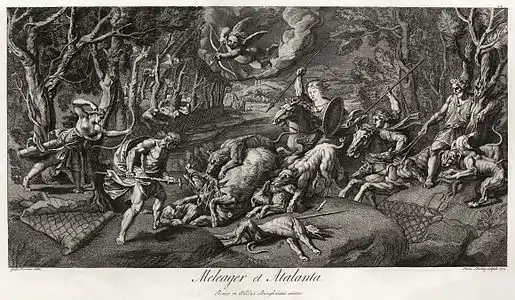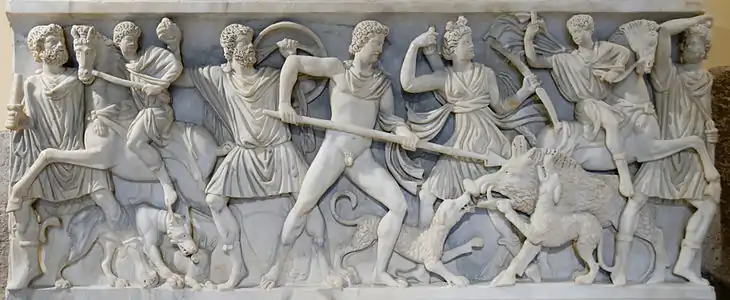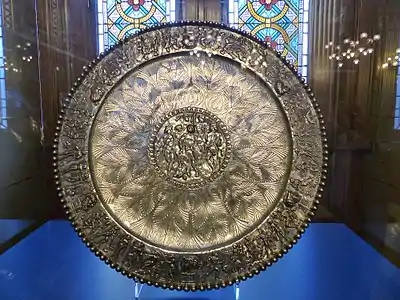Meleager
In Greek mythology, Meleager (/ˌmɛliˈeɪɡər/,[1] Greek: Μελέαγρος, translit. Meléagros) was a hero venerated in his temenos at Calydon in Aetolia. He was already famed as the host of the Calydonian boar hunt in the epic tradition that was reworked by Homer.[2] Meleager is also mentioned as one of the Argonauts.
| Meleager | |
|---|---|
Prince of Calydon | |
 | |
| Abode | Calydon |
| Personal information | |
| Parents | Oineus and Althaea |
| Siblings | Deianira |
| Consort | Atalanta Cleopatra |
| Offspring | Parthenpaios |
| Part of a series on |
| Greek mythology |
|---|
_02.jpg.webp) |
| Deities |
| Heroes and heroism |
| Related |
|
|
Biography
Meleager was a Calydonian prince as the son of Althaea and the vintner King Oeneus[3] or according to some, of the god Ares.[4][5] He was the brother of Deianeira, Toxeus, Clymenus, Periphas, Agelaus (or Ageleus), Thyreus (or Phereus or Pheres), Gorge, Eurymede and Melanippe.[3][6]
Meleager was the father of Parthenopeus by Atalanta[7] but he married Cleopatra, daughter of Idas and Marpessa.[8] They had a daughter, Polydora, who became the bride of Protesilaus, who left her bed on their wedding-night to join the expedition to Troy.
Mythology
Calydonian boar hunt
_-_Napoli_MAN_8980.jpg.webp)
When Meleager was born, the Moirai (the Fates) predicted he would only live until a piece of wood, then burning in the family hearth, was consumed by fire. Overhearing them, Althaea immediately doused and hid it.[9]
Oeneus sent Meleager to gather up heroes from all over Greece[10] to hunt the Calydonian boar that had been terrorizing the area and rooting up the vines, as Oeneus had omitted Artemis at a festival in which he honored the other gods. In addition to the heroes he required, he chose Atalanta, a fierce huntress, whom he loved.[11] According to one account of the hunt, when Hylaeus and Rhaecus, two centaurs, tried to rape Atalanta, Meleager killed them. Then Atalanta wounded the boar and Meleager killed it. He awarded her the hide since she had drawn the first drop of blood.
Meleager's uncles Toxeus, the "archer",[12] and Plexippus grew enraged that the prize was given to a woman. Meleager killed them in the following argument.[13] He also killed Iphicles and Eurypylus for insulting Atalanta. When Althaea found out that Meleager had killed her brothers, she placed the piece of wood that she had stolen from the Fates (the one that the Fates predicted, once engulfed with fire, would kill Meleager) upon the fire, thus fulfilling the prophecy and killing Meleager, her own son.[14] Meleager's sisters who mourned his death excessively were turned into guineafowl (meleagrides).[15]
Afterlife
In the underworld, his was the only shade that did not flee Heracles, who had come after Cerberus. In Bacchylides' Ode V, Meleager is depicted as still in his shining armor, so formidable, in Bacchylides' account, that Heracles reached for his bow to defend himself. Heracles was moved to tears by Meleager's account; Meleager had left his sister[16] Deianira unwedded in his father's house, and entreated Heracles to take her as his bride;[17] here Bacchylides breaks off his account of the meeting, without noting that in this way Heracles in the underworld chooses a disastrous wife.
According to Pliny the Elder's Natural History, Book 37, Chapter 11, Sophocles believed that amber is produced in the countries beyond India, from the tears that are shed for Meleager, by the birds called "meleagrides".[18]
Influences
Among the Romans, the heroes assembled by Meleager for the Calydonian hunt provided a theme of multiple nudes in striking action, to be portrayed frieze-like on sarcophagi.
Meleager's story has similarities with the Scandinavian Norna-Gests þáttr.
Family tree
Gallery
- Meleager in art
 Meleager et Atalanta, after Giulio Romano
Meleager et Atalanta, after Giulio Romano Statue of Meleager modeled after Skopas
Statue of Meleager modeled after Skopas Meleager sarcophagus
Meleager sarcophagus Meleager and Atalanta (17th century) by Jacob Jordaens
Meleager and Atalanta (17th century) by Jacob Jordaens Volterra, Italy. Etruscan cinerary urn; Hunt of Maleager, Volterra. Brooklyn Museum Archives, Goodyear Archival Collection
Volterra, Italy. Etruscan cinerary urn; Hunt of Maleager, Volterra. Brooklyn Museum Archives, Goodyear Archival Collection Meleager, Scopas' influence. Brooklyn Museum Archives, Goodyear Archival Collection
Meleager, Scopas' influence. Brooklyn Museum Archives, Goodyear Archival Collection
 Meleager plate
Meleager plate.jpg.webp) Meleager plate (detail)
Meleager plate (detail) Renaissance sculpture of Meleager by Pier Jacopo Alari Bonacolsi, who was known by his contemporaries as L'Antico. V&A Museum.
Renaissance sculpture of Meleager by Pier Jacopo Alari Bonacolsi, who was known by his contemporaries as L'Antico. V&A Museum.
References
- Wells, John C. (2009). "Meleager". Longman Pronunciation Dictionary. London: Pearson Longman. ISBN 978-1-4058-8118-0.
- Homer, Iliad 9.529–99
- Antoninus Liberalis, 2 as cited in Nicander's Metamorphoses
- Hyginus, Fabulae 14 & 171
- Apollodorus, 1.8.2
- Hesiod, Ehoiai fr. 98 as cited in Berlin Papyri, No. 9777
- Hyginus, Fabulae 70 & 99
- Kerenyi 1959: Genealogical table F, p. 372.
- Hyginus, Fabulae 171; Apollodorus, 1.8.2
- Apollodorus, 1.8.2
- Euripides, Frg. 520, noted by Karl Kerenyi, The Heroes of the Greeks, 1959:119 note 673.
- There were two further brothers, Thyreus, the "porter", and Klymenos, the "famous"—though Meleager is by far the most renowned of the four—and two sisters, Gorge and Deianira (Kerenyi 1959:199 and Genealogical table G, p. 375).
- Hyginus, Fabulae 244
- Hyginus, Fabulae 239 & 249
- Hyginus, Fabulae 174
- Or perhaps his half-sister, if Dionysus was the real father of Deianira, as Apollodorus, 1.8.1, would have it; Oeneus himself was "to judge by his name a double of the wine-god", as Kerenyi observes (Kerenyi 1959:199).
- Scholia on Iliad 21.194, noted by Kerenyi 1959:180 note 103.
- "Pliny the Elder, The Natural History, BOOK XXXVII. THE NATURAL HISTORY OF PRECIOUS STONES., CHAP. 11.—AMBER: THE MANY FALSEHOODS THAT HAVE BEEN TOLD ABOUT IT". www.perseus.tufts.edu. Retrieved 2023-03-19.
Sources
- Bacchylides Fr 5.93
- Apollonius Rhodius, Argonautica I, 190–201.
- Pseudo-Apollodorus, Bibliotheca I, viii, 1–3.
- Ovid, Metamorphoses VIII, 269–525.
External links
- The Warburg Institute Iconographic Database (images of Meleager)
 Media related to Meleager at Wikimedia Commons
Media related to Meleager at Wikimedia Commons